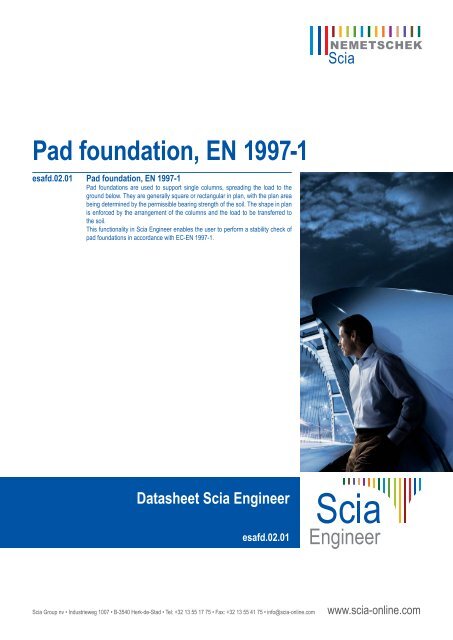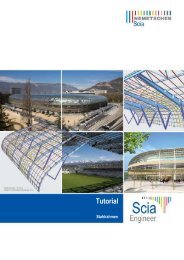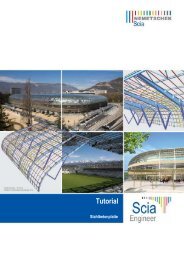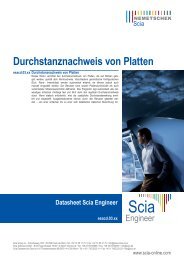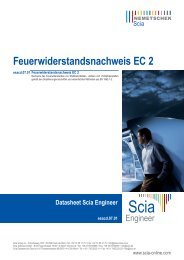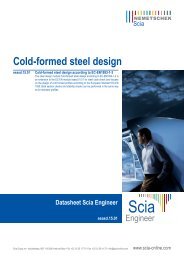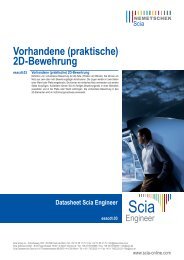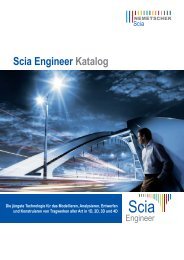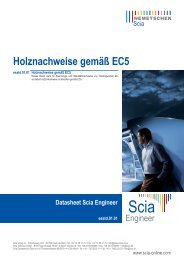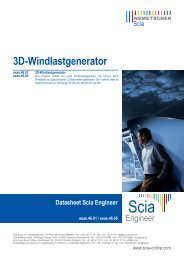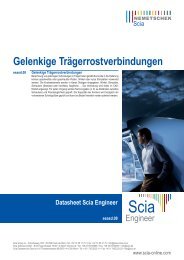Foundation blocks - Eurocodes
Foundation blocks - Eurocodes
Foundation blocks - Eurocodes
Create successful ePaper yourself
Turn your PDF publications into a flip-book with our unique Google optimized e-Paper software.
Pad foundation, EN 1997-1<br />
esafd.02.01 Pad foundation, EN 1997-1<br />
Pad foundations are used to support single columns, spreading the load to the<br />
ground below. They are generally square or rectangular in plan, with the plan area<br />
being determined by the permissible bearing strength of the soil. The shape in plan<br />
is enforced by the arrangement of the columns and the load to be transferred to<br />
the soil.<br />
This functionality in Scia Engineer enables the user to perform a stability check of<br />
pad foundations in accordance with EC-EN 1997-1.<br />
Datasheet Scia Engineer<br />
esafd.02.01<br />
Scia Group nv • Industrieweg 1007 • B-3540 Herk-de-Stad • Tel: +32 13 55 17 75 • Fax: +32 13 55 41 75 • info@scia-online.com www.scia-online.com
The support type Pad foundation (previously<br />
called ‘<strong>Foundation</strong> block’) extends a wide set of<br />
support types in Scia Engineer. From now on,<br />
besides the stiffness which is taken into account<br />
under the structure, it is also possible to check<br />
the stability of the pad foundation according to<br />
EN 1997-1: Geotechnical design-Part 1: General<br />
rules, 2004.<br />
Three separate checks can be executed:<br />
• Bearing resistance check;<br />
• Sliding resistance check;<br />
• Eccentricity check.<br />
Furthermore, the AutoDesign tool is introduced to<br />
optimize the dimensions of the pad foundation.<br />
It is possible to input the maximum stress received<br />
from a geotechnical report and use this value for<br />
the automatic design.<br />
The pad foundation properties are defi ned by:<br />
• Pad foundation geometry;<br />
• Subsoil properties.<br />
Design and optimization tools are available for<br />
single or multiple selected pad foundations as well<br />
as in the Overall AutoDesign for optimization of all<br />
pad foundations in the model.<br />
Geotechnical combinations<br />
Set B and set C of the EN-ULS (STR/GEO) combination<br />
defi ned in EN 1990 are available for the<br />
foundation check.<br />
For the check a result class GEO is automatically<br />
created. This class contains all combinations of<br />
types: EN-ULS (STR/GEO) Set B and EN-ULS<br />
(STR/GEO) Set C. The latter is specifi cally used<br />
for Geotechnical Design according to Design<br />
Approach 1.<br />
Pad foundation input<br />
Easy-to-use Pad foundation dialog is used for<br />
input of geometry and other properties of pad<br />
foundations.<br />
Moreover, the subsoil library is linked to the pad<br />
foundation properties.<br />
Pad foundation stability check<br />
In general, three separate checks are executed:<br />
• A Bearing resistance check is executed according<br />
to art.6.5.2 and Annex D of EN 1997-1. The<br />
vertical design loading Vd should be equal or<br />
smaller than the bearing resistance Rd.<br />
• A Sliding resistance check is executed according<br />
to art. 6.5.3 of EN 1997-1. The horizontal<br />
design loading Hd should be equal or smaller<br />
than the sum of the sliding resistance Rd and<br />
the positive effect of the earth pressure at the<br />
side of the foundation Rp,d.<br />
• An Eccentricity check is executed according to<br />
art.6.5.4 of EN 1997-1: special precautions are<br />
required for loads with large eccentricities.<br />
When executing the check, the safety and resistance<br />
factors which are applied depend on one of<br />
the 3 design approaches chosen in the geotechnics<br />
setup.<br />
AutoDesign<br />
An optimization tool for pad foundations is also<br />
available. This enables the user to search easily<br />
for an optimal geometry of the foundation block.<br />
The user can choose any of the pad foundation<br />
dimensions or even optimize several parameters<br />
in one step. This is called sensitivity optimization:<br />
it verifi es the sensitivity of different parameters to<br />
the check.<br />
The maximum check limit is confi gurable for each<br />
of the three main checks.<br />
Pad foundation, EN 1997-1<br />
Highlights NEW<br />
► Both the stability check and the autodesign<br />
of pad foundations have an optimal performance<br />
speed.<br />
► User is able to check both the superstructure<br />
as the foundations.<br />
► Optimization tool: the AutoDesign of pad<br />
foundations can be carried out in a fast way.<br />
The user is able to optimize one or more<br />
dimensions of the pad foundation. With the<br />
sensitivity optimization, several parameters<br />
can be optimized together. Scia Engineer<br />
will give as fi nal result a pad foundation with<br />
the most optimal geometry dimensions.<br />
► The AutoDesign of Pad foundations can be<br />
performed together with the AutoDesign of<br />
structures.<br />
► A detailed output with input data, results and<br />
used articles is available. This output can be<br />
sent to the document for the fi nal report.<br />
► A unity check can be performed: this gives<br />
as result the most critical value of the three<br />
checks. This prevents that the user has to<br />
perform each check seperately.<br />
esafd.02.01


